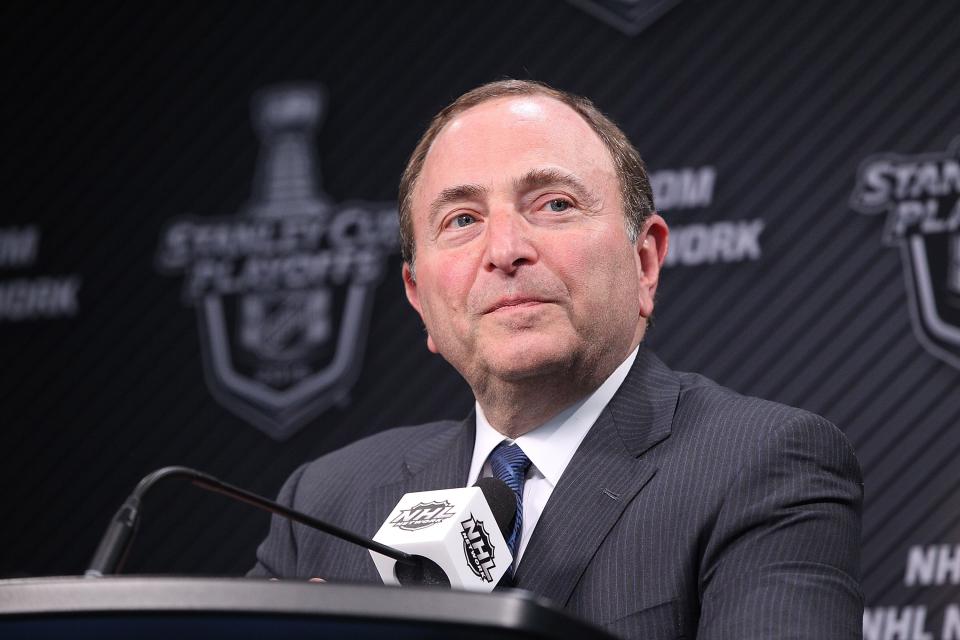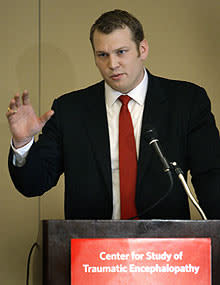Why Gary Bettman really should have kept his mouth shut on CTE

CHICAGO – Gary Bettman is a lawyer. Too often he speaks like a lawyer when he should speak as a leader. Thursday was one of those times.
The commissioner of the National Hockey League held an informal media scrum during the first intermission of Game 3 of the Western Conference final between the Anaheim Ducks and the Chicago Blackhawks. He stood at the back of the press box, surrounded by reporters, and answered questions about subjects like the salary cap.
Then he made a comment about chronic traumatic encephalopathy (CTE), which Boston University researchers describe as a “progressive degenerative disease of the brain found in athletes (and others) with a history of repetitive brain trauma, including symptomatic concussions as well as asymptomatic subconcussive hits to the head.”
“From a medical science standpoint, there is no evidence yet that one necessarily leads to the other,” Bettman said amid the noise of the United Center. “I know there are a lot of theories, but if you ask people who study it, they tell you there is no statistical correlation that can definitively make that conclusion.”
This was not news, in a sense. Bettman has said this many times before, or something close to it. But the timing was terrible. Former NHL defenseman Steve Montador died, researchers found CTE in his brain and his family became the latest to sue the league.
The negative reaction was immediate. Chris Nowinski, a leading CTE activist, tweeted: “If ‘necessarily’ means ‘always,’ fine. If not, then ‘no evidence’ is untrue. We have ‘some’ pretty good evidence.” Columnists and lawyers howled.
Bettman would have been better off saying nothing. This issue is too delicate, too complex and too multi-faceted for a between-periods media scrum, let alone Twitter. Bettman’s full quote couldn’t even fit into 140 characters. How can people possibly understand the issue in that context?
But people need to get past Bettman and his quote, and they need to understand the issue in the full context. They need to separate the parts:
-- There is the court battle. Former players and their families are suing the league. Their lawyers need to prove brain trauma suffered in the NHL led to medical problems, that the league knew the danger and didn’t take adequate steps to inform and protect. The NHL’s lawyers are going to fight that. Of course they are. Millions of dollars are at stake.
-- There is the science. CTE cannot be denied. But it’s not that simple. What we have now are case studies from biased samples. An athlete died. He had symptoms. He had a history of repetitive brain trauma. Researchers cut into his brain and found tau protein. They conclude there is a correlation between the symptoms and the history of repetitive brain trauma.
But there is a long way to go to determine causation and incidence and prevalence. We still don’t know how brain trauma affects individual people and why. Are some people more sensitive to brain trauma than others? Does the disease progress differently in different people under different circumstances? How does tau in the brain correspond to clinical symptoms in different people?
In short, why can one man have a long NHL career and a long life without symptoms, while another has a short career, quick symptoms and a short life? We need to do long-term studies with controls to find out. Those studies are being conducted.
There is also the fear that former athletes suffer symptoms, hear about CTE, assume the worst and commit suicide because of it, when it’s hard to untangle all the factors involved – from brain trauma to dealing with retirement – and their depression could be treated.
That’s why Bettman, the lawyer, said there is no evidence yet that one “necessarily” leads to the other. That’s why Nowinski, the activist, substituted the word “necessarily” with “always.”

“It’s an unknown risk,” Nowinski told me in an interview in 2011. “We’re finding it in more athletes who played a long time than we’d like. We’re finding it in young athletes who didn’t play a long time, which is concerning, but we have no idea again what the percentage is. But it’s a real risk, and we should change our behaviors.”
Nowinski is absolutely right. Even if the risk is unknown, it’s a real risk. We should change our behaviors. Which leads to the last point:
-- There is the preventive action. While the lawyers argue and the scientists research, the NHL needs to take steps to reduce brain trauma and improve treatment for it, if only because of what might happen to players. It has been doing that. It continues to do so. It will continue to do so.
Bettman needs to be accountable for what he says. The league needs to be held accountable for what it does.
But this was also the first league to introduce baseline testing and return-to-play protocol. It has made rule changes, like introducing an illegal check to the head. It has made rink changes, like introducing curved glass at termination points. It has strengthened the return-to-play protocol, at least threatening discipline to teams that break it.
It created the department of player safety, not only to issue suspensions, but to explain them on video and educate everyone. It is studying equipment changes.
Has the league done enough? No. As long as fighting is a five-minute penalty, the league will look hypocritical. But fighting has declined over the years to a substantial degree thanks to a variety of factors. Enforcers are an endangered species. It’s no accident.
Can the league ever do enough? No. Not from a medical standpoint. Not if hockey is still hockey as we know it. The league is walking a fine line, trying to keep the game physical but make it safer at the same time.
It’s not easy. At the bottom of the front page of the sports section in Saturday’s Chicago Tribune, there was article with the headline: “Bettman takes hit over CTE quote.” Above it was the main package, with a big picture of the Ducks’ Ryan Getzlaf drilling the Blackhawks’ Brad Richards. The headline: “WORLD OF HURT. Ducks hitting hard – and Hawks feeling it.”
Again, CTE is thought to be caused by repetitive brain trauma, not only concussions, and hockey is a violent game. Hits are physical and psychological weapons. Ducks forward Kyle Palmieri talked about a hit on Blackhawks forward Patrick Kane.
“We don’t want to run out of our way to make hits,” he told the Tribune. “That one just presented itself, and I just wanted to separate him from the puck. You want to put as hard a hit on him as you can.”

 Yahoo Sports
Yahoo Sports 